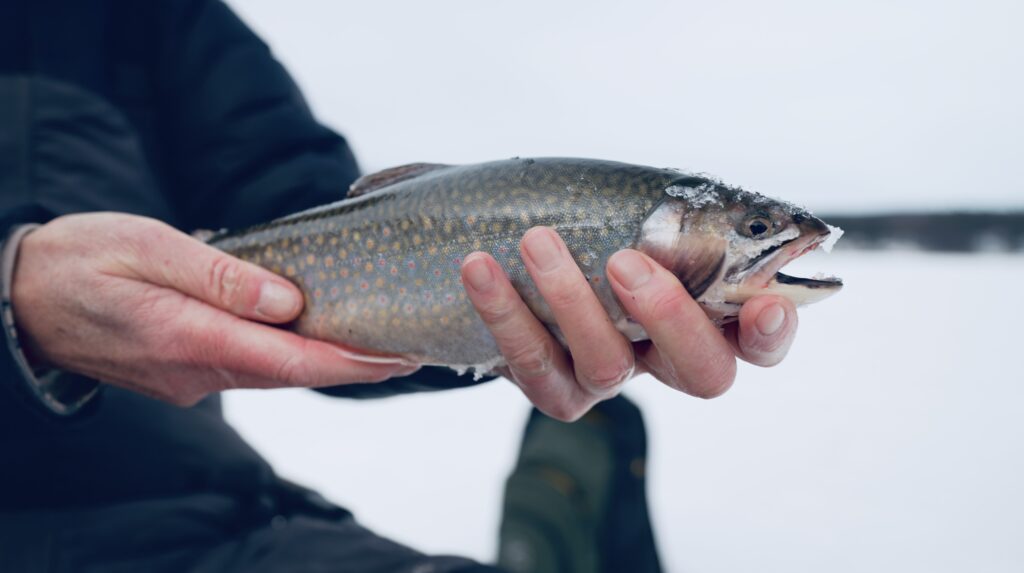Origin of Brook Trout in B.C.
You’ve got an eastern brook trout on the end of your line. Ever wonder where that fish came from?
Brook trout have been stocked in B.C. for over a century; they increase the diversity of fishing for B.C. anglers. But, as the name implies, eastern brook trout are not originally from around here. While the ancestors of the Freshwater Fisheries Society of BC’s strain originated in Ontario, we now keep a reproductive population just for egg-collection purposes. Since brook trout are fall-spawners, our fish culturists spawn brook trout every October. The fertilized eggs are incubated, and then the newly hatched fish are allowed to grow to fry or fingerling sizes at the Summerland, Clearwater, and Kootenay Trout Hatcheries for stocking into lakes.
Brook Trout or Brook Char?
Brook trout aren’t, in fact, a trout at all, but a char. Salvelinus fontinalis, or brook char, are native to eastern North America, and are most closely related to bull trout, arctic char, and lake trout. Advances in taxonomy over the years have allowed us to identify these four species as char in the Salvelinus genus, but convention keeps us calling brookies and lakers “trout,” as we have been doing for hundreds of years.
Given the changing conservation ethic over the years, all brook trout stocked in B.C. are now non-reproductive females (also called sterile females, all-female triploids, or AF3n for short). The Society also produces all-female strains of rainbow trout and kokanee. Stocking only sterile females helps reduce genetic risks to wild stocks, as no males mean no natural reproduction –and improved fisheries for anglers.

How Does Stocking only Sterile Females Improve a Fishery?
A combination of factors result in an improved fishery when stocking only sterile females. First consider that, as with other salmonids, male brook trout are more likely to become sexually mature (“jacks”) at a younger age than females. Secondly, many brook trout die after spawning. And finally, even sterile triploid (or 3n) males still put energy into sexual development, and exhibit the associated deterioration of flesh that is normal for salmonids after spawning. On the other hand, sterile females put all of their energy into body growth.
Collectively, this means that if you stock both sexes, approximately half of the fish are prone to stopping growth early to start the process of sexual maturation and death. When only sterile females are stocked, fish can grow larger, stay silvery, and live longer. In addition, in systems where we want additional control over a population, stocking only females results in no natural reproduction.
Sex-Reversal and Other Tricks
We touched on this in an earlier blog post in this series: all-female strains are produced by sex-reversing one of the parents. Even though salmonids have XX (female) or XY (male) pairs of chromosomes just like humans, many fish species tend to be very plastic in the development of their sexual identity. This means that sometimes a fish without a Y-chromosome can develop as a male, even though it doesn’t have the genetic material of a male. This is an example of sex-reversal. We capitalize on this trait, and can fertilize normal females’ eggs with sperm from sex-reversed females, to produce all-female offspring with no Y chromosomes in the mix at all.
After fertilization, the brook trout eggs are then rendered sterile by applying a controlled increase in pressure at a very specific time. This results in the developing egg retaining a third set of chromosomes. This extra genetic material will interrupt the fish’s ability to produce eggs in the future. After these sterile female brook trout are grown to a weight of about three to 10 grams, they are stocked into small lakes.
Which Lakes Are Stocked with Eastern Brook Trout?
Every year, our hatcheries raise and release over six million trout, char, and kokanee – from juvenile fry to catchable-sized fish. To see where we stock eastern brook trout, use the detailed Fish Stocking Reports tool on our website, and filter by Eastern Brook Trout under Stock Species. And to learn more about the unique traits of the species and strains we stock, including their habitat preferences and tips to help you fish, visit the Stocked Strains section of our website.
Author: Kirstin Gale, Freshwater Fisheries Society of BC
Original publish date: November 7, 2019
